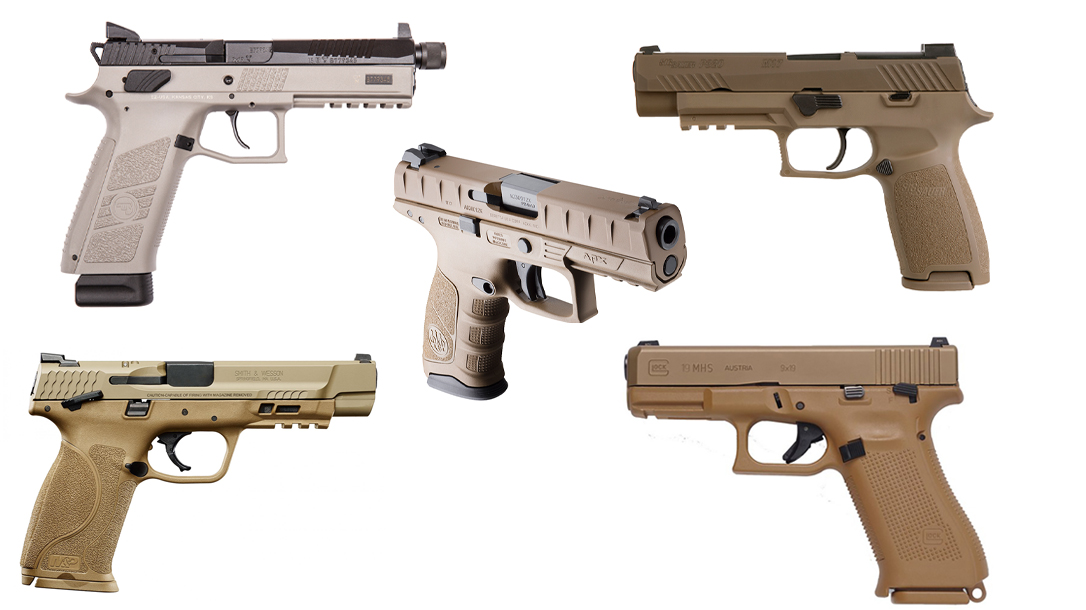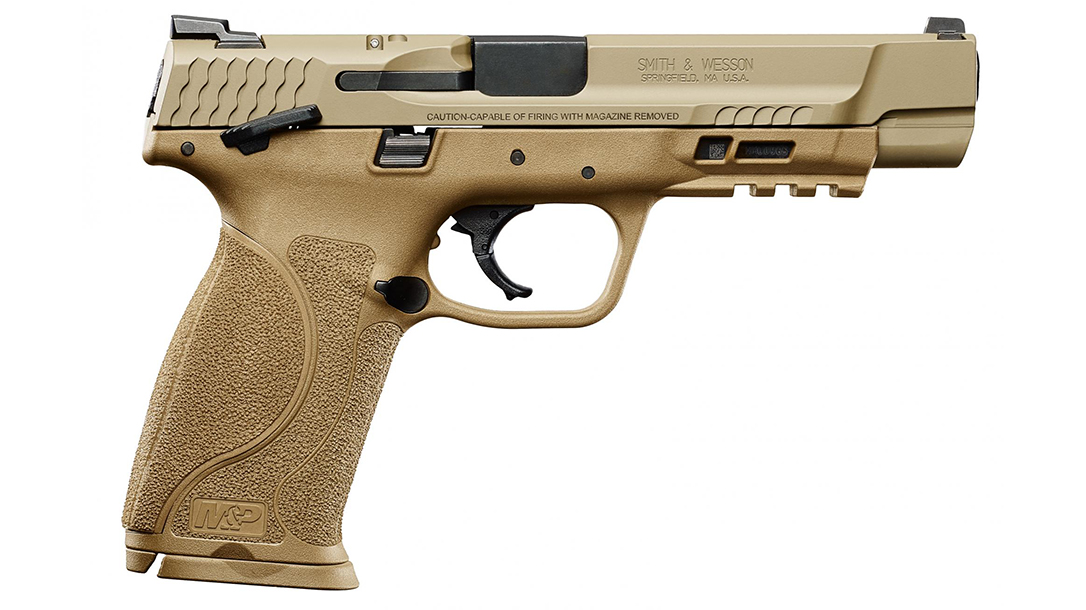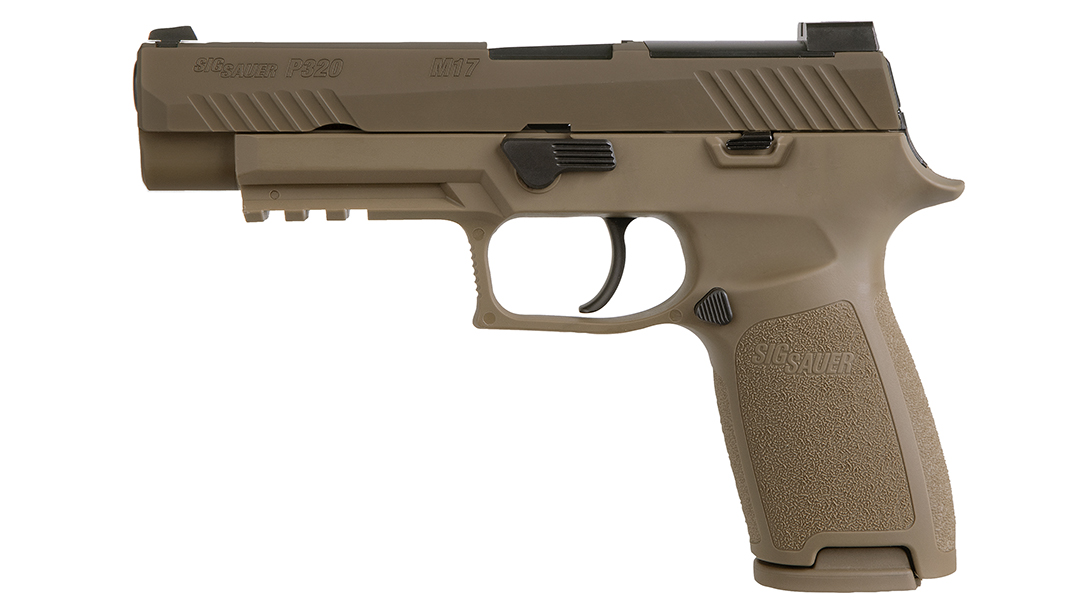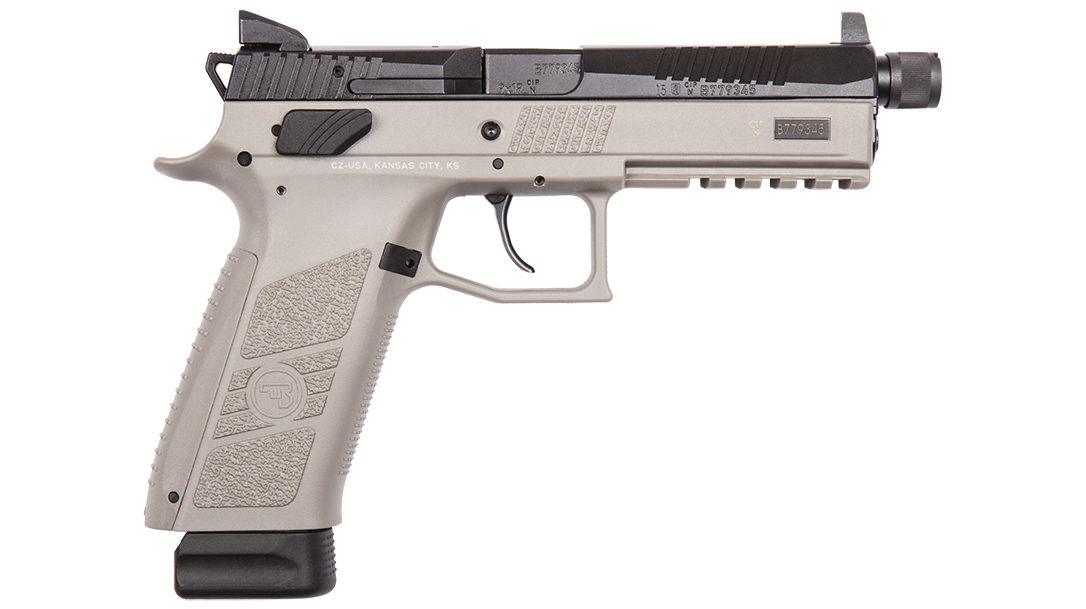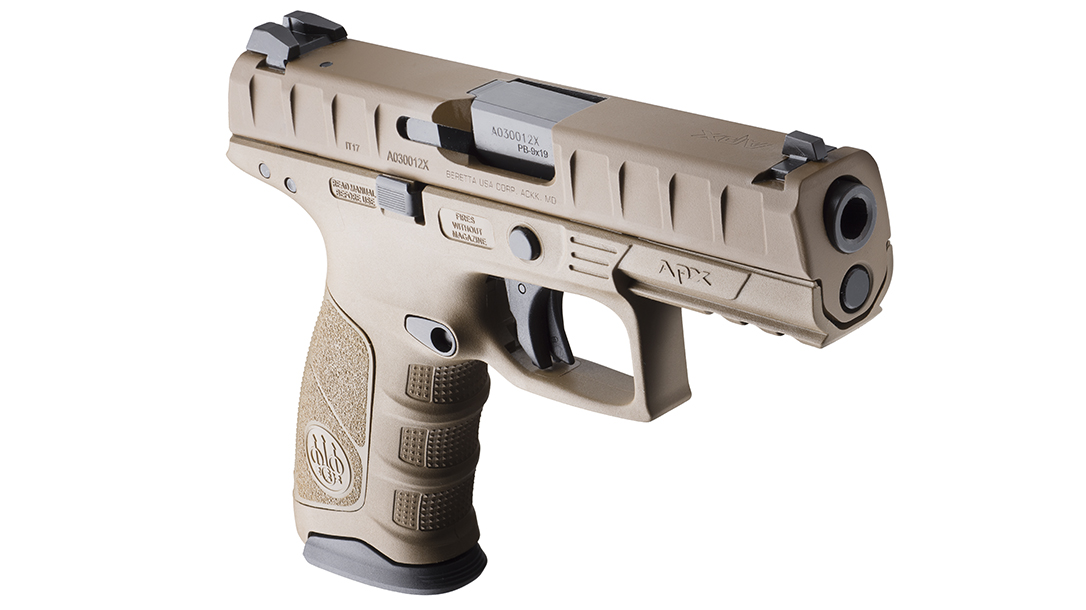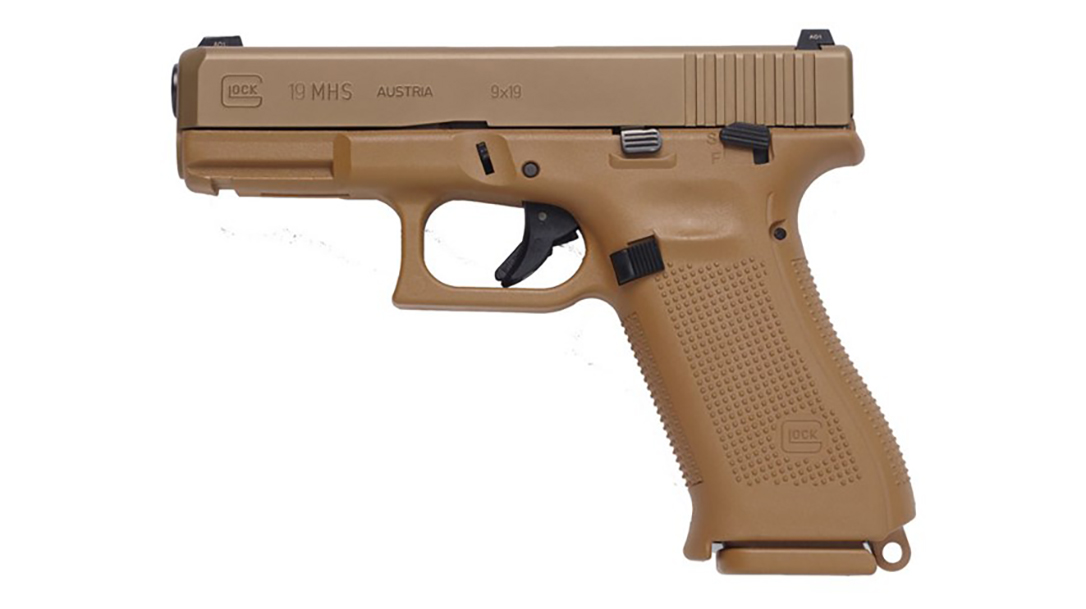In 2011, the U.S. Army and Air Force announced their Modular Handgun System (MHS) trials to find a new service pistol to replace the M9 (Beretta) and M11 (Sig) pistols and those 1911s still in limited service.
The Army set out several requirements that became more focused over the years. Originally, it wanted one 9mm that could be configured as both full-sized (M17) and compact (M18) variants. Other MHS requirements included a slide cut for mounting a miniature reflex sight; ambidextrous controls, including a thumb safety; a loaded-chamber indicator; an improved slide subassembly to capture small components when disassembled; a trigger design that prevents foreign debris from entering the action; and a corrosion-resistant PVD finish on metal components. The barrel lengths for the M17 and M18 come in around 4.7 and 3.9 inches, respectively. The Army also asked that the guns use standard 17-round magazines as well as extended 21-round magazines.
Advertisement — Continue Reading Below
In addition, the handgun needed to have a 90-percent or greater chance of hitting a 4-inch circle out to 50 meters consistently throughout its lifetime, and its ergonomic design should minimize recoil and control shot dispersion.
Army Testing Protocol of the Modular Handgun System
The Army desired 2,000 mean rounds between stoppages, 10,000 mean rounds between failures and a 35,000-round service life. Multiple delays pushed the solicitation deadline to February 2016.
Several companies submitted pistols, including Beretta, CZ, Glock, Smith & Wesson and Sig Sauer. Eventually, the Army narrowed the group down to Glock and SIG before the latter went on to win the contract. The Sig P320 was chosen as the Army’s new pistol, designated the M17. Of course, as with all U.S. military trials since the adoption of the Model 1795 flintlock musket, the results of the MHS competition led to much debate among civilian shooters. And let’s not even mention how the 1911/.45 ACP crowd felt about it!
Advertisement — Continue Reading Below
So, with all that in mind, we felt it would be educational to pit a few gun as close to the MHS contenders as possible against one another in this “Battle Royale.” Our pistols include the Beretta APX, CZ P-09 Suppressor-Ready, Glock 19X, Sig Sauer P320-M17 and Smith & Wesson M&P9 M2.0.
Modular Handgun System Contenders
Right off the bat, all five of these 9mm pistols utilize polymer frames and steel slides, and all but the Sig can be fitted with interchangeable backstraps so you can customize the grip to fit your hands better. (Sig offers replacement frames, or grip modules, in small, medium and large sizes.) They all have dust-cover Picatinny rails for mounting lights and/or lasers.
Four of pistols are striker-fired while the CZ stands out with its external hammer and DA/SA trigger system. None of the striker-fired pistols offer a second-strike capability, so if you experience a misfire, you have to retract the slide slightly to reset the striker. And while all of the MHS contenders had night sights, only the CZ, Glock and Sig we received for testing came fitted with them. The Beretta and S&W came with traditional three-dot sights. The Glock and Sig front sights had tritium inserts surrounded by white rings for faster targeting in every lighting condition, and the Sig also stood out because it has a plate at the rear of the slide that can be removed for mounting a reflex sight.
Advertisement — Continue Reading Below
The G19X pistols submitted for the MHS trails featured ambidextrous thumb safeties, but Glock decided not to offer them on the commercial market. Our S&W and Sig pistols came with ambidextrous safeties, and the CZ had an ambidextrous decocker. A safety is an option on the Beretta. The magazine releases and slide stop levers were all located in the proper positions, and the former can be switched from port to starboard for the Southpaws among us.
In terms of capacity, the Beretta, Glock, S&W and Sig all use 17-round magazines while the CZ’s extended mag can hold 20 rounds. The G19X also came with extended 19-round mags.
Range Rules
As is our SOP in these shootouts, my wife, Becky, and I zeroed each pistol from an MTM K-Zone rest at 15 yards, and we were pleased to see that all four were capable of producing groups 2 inches or less in size.
Advertisement — Continue Reading Below
We then field-stripped, cleaned and lubricated each pistol—the only maintenance they received. If one malfunctioned, we would attempt to correct the problem at the range. If we were unable to do so, the pistol would be scored up to that point and then put aside while we finished testing the remaining handguns.
My friends and “Battle Royale” compatriots Dick Jones and Richard Cole helped me evaluate the pistols, and we decided upon the following three drills:
Steel Plate Drill
From 10 yards, the shooter engages a rack of six 8-inch steel plates with the score being the average time for four runs. Any plate left standing would add a five-second penalty. For this drill, each pistol was loaded with 10 rounds of ammo.
Advertisement — Continue Reading Below
- Pistol: Dick, Paul, Richard
- Beretta: 9.4, 7.5, 6.2
- CZ: 8.9, 7.5, 7.3
- Glock: 7.5, 7.4, 6.9
- Sig Sauer: 8.2, 6.5, 7.6
- S&W: 7.2, 5.8, 4.7
Paper/Popper Drill
From 10 yards, the shooter double-taps a pair of cardboard targets, then shoots a Birchwood-Casey self-setting steel popper before engaging two more cardboard targets on the other side. Shooter must hit the popper before engaging the remaining targets. They then perform a combat reload and repeat the drill. The drill is run one more time with the score being the total time for both runs plus a five-second penalty for any miss.
- Pistol: Dick, Paul, Richard
- Beretta: 33.7, 32.6, 28.6
- CZ:48.4, 30.3, 36.1
- Glock: 50.2, 35.3, 40.1
- Sig Sauer: 34.5, 32.5, 33.2
- S&W: 33.3, 29.5, 38.5
Speed Drill
The shooter begins facing three steel targets at 10, 15 and 20 yards. They raise their pistol and fire 10 rounds at the first target, reload, engage the second target, reload and engage the third target. The score consists of the total time plus five-second penalties for any misses.
In the end, each shooter had to fire a minimum of 90 rounds through each pistol with a total of 450 rounds from all five. Our test ammo consisted of Black Hills and Sig 115-grain FMJs. The Target Barn provided ISPC cardboard targets, and Competition Electronics gave us a Pocket Pro shot timer. Finally, as in previous “Battle Royales,” each pistol was graded on a 1 (worse) to 5 (best) scale in seven categories: Reliability, ergonomics, trigger control, recoil control, sights, off-hand accuracy and reloading ease. We then added these together to give each pistol a final score in each category, with 15 being a perfect score.
Advertisement — Continue Reading Below
- Pistol: Dick, Paul, Richard
- Beretta: 35.0, 39.4, 31.5
- CZ: 31.0, 34.0, 28.7
- Glock: 28.4, 35.8, 26.4
- Sig Sauer: 29.7, 26.6, 27.7
- S&W: 27.3, 27.1, 27.3
In-Depth Results of the Modular Handgun System Submission
Reliability
The Beretta, CZ and Glock pistols all received perfect scores in this category. The only reason it wasn’t a five-way tie is that we experienced a total of four light strikes/misfires with the S&W and SIG. They all happened towards the end of our testing when the pistols were all quite dirty.
Ergonomics
The S&W ran away with this category thanks to its excellent grip angle, balance, texturing and control locations. One shooter said. “I didn’t expect to like it, but I was wrong.” Two of the shooters said that when they brought the Glock or Beretta up to fire, they tended to point low, even with the medium-sized backstraps. Everyone criticized the grasping grooves on the Beretta’s slide, saying they were too far apart and smooth to get a firm purchase. Two of us disliked the way the CZ sat so high in our hands, and its rather small grasping grooves also came in for some criticism. All of us felt the beavertail on the Sig was too short while the safety was hard to manipulate.
Trigger Control
Thanks to their short, light trigger pulls the Sig and S&W pulled ahead of the pack in this category. In fact, one shooter felt the Sig’s trigger was closer to a single-action design. The Glock’s trigger was the heaviest and grittiest of the lot, with the Beretta’s being only slightly more user friendly. The CZ was hard to compare to the others because of its DA/SA trigger system. That said, the DA pull was rather long and gritty while the SA pull was fairly crisp.
Advertisement — Continue Reading Below
Recoil Control
Thanks its excellent ergonomics, the S&W once again scored perfectly here, with the Sig coming in second place due to its beavertail and high bore axis. The Glock and Beretta tied for third place here. We felt the APX delivered sharper recoil. The CZ lost points because two of us felt it sat too high in the hand, and the grip texturing allowed it to move around under recoil, as with the Beretta.
Pistol Sights
Thanks to their tritium sights, the Sig and Glock dominated here. While the CZ, S&W and Beretta had the usual three-white-dot setup, the S&W allowed for a finer sight picture. Two of us disliked how tall the CZ’s sights were, but CZ designed them to work with a suppressor installed.
Reloading Ease
This category was a four-way tie—for second place! While all five pistols proved easy to reload, we all felt that the S&W’s ergonomics us allowed us to hit the magazine release without moving the gun around in our hands.
Advertisement — Continue Reading Below
Of course, while our mini-MHS trial is interesting, it isn’t anywhere near as severe as what the Army put these pistols through. We couldn’t get anywhere near the astronomically high round count of the Army trials, but most shooters won’t, either. And the manufacturers might have been upset with us if we had tried!
As I always do at the end of these shootouts, I asked my friends which test gun was their favorite. The consensus was unanimous. We all agreed on the Smith & Wesson M&P9 M2.0!
For more information, visit beretta.com, cz-usa.com, glock.com, sigsauer.com and smith-wesson.com.
Modular Handgun System Final Scores
This article is from the July/August 2019 issue of Combat Handguns magazine. Grab your copy at OutdoorGroupStore.com. For digital editions, visit Amazon.
